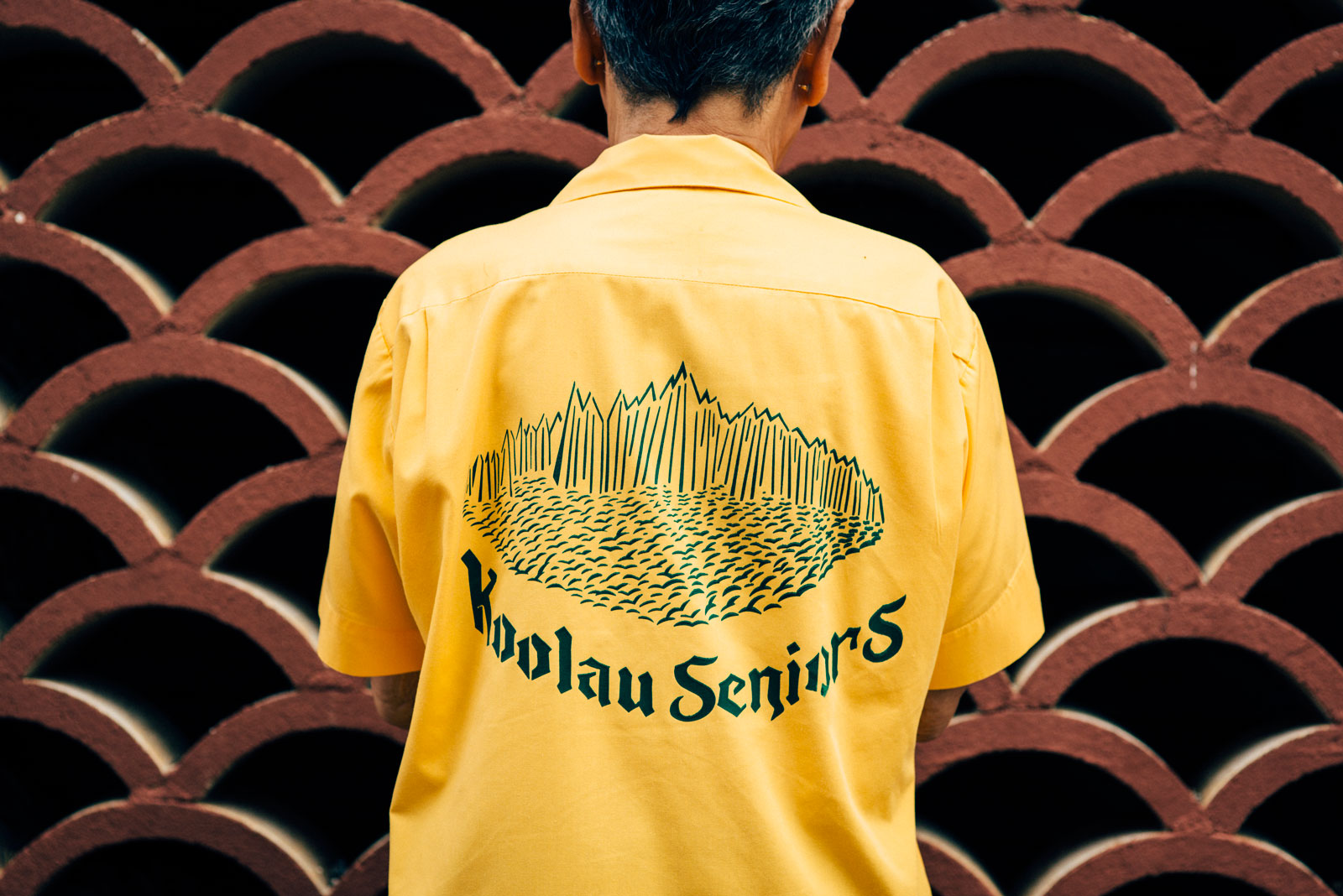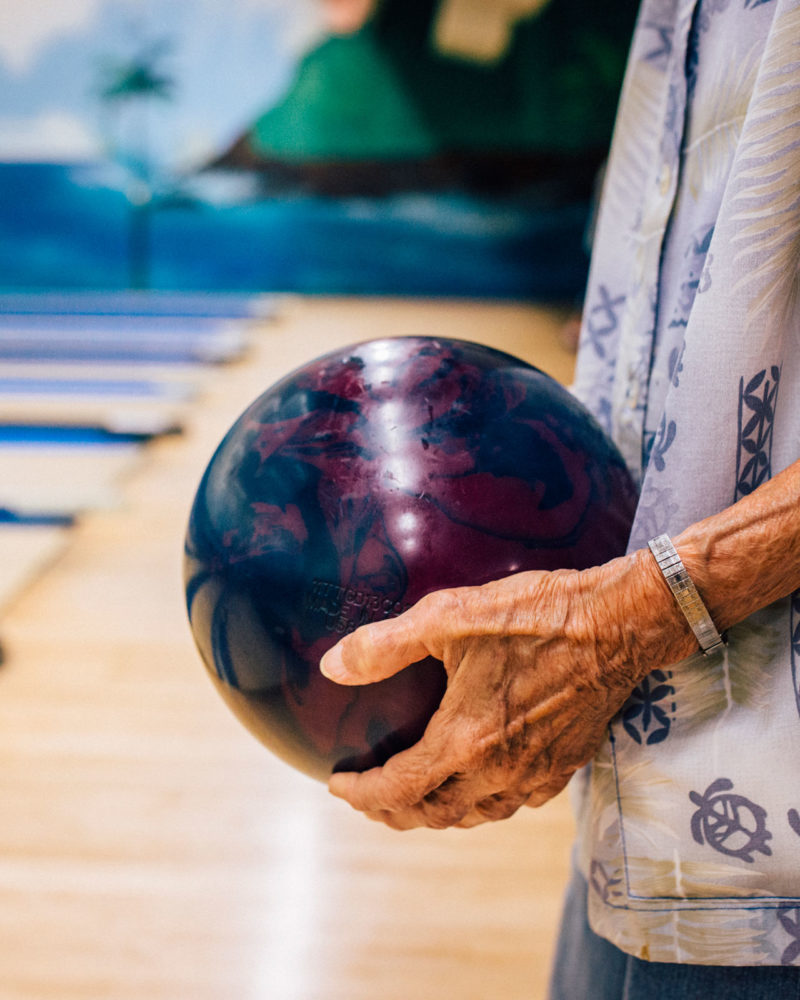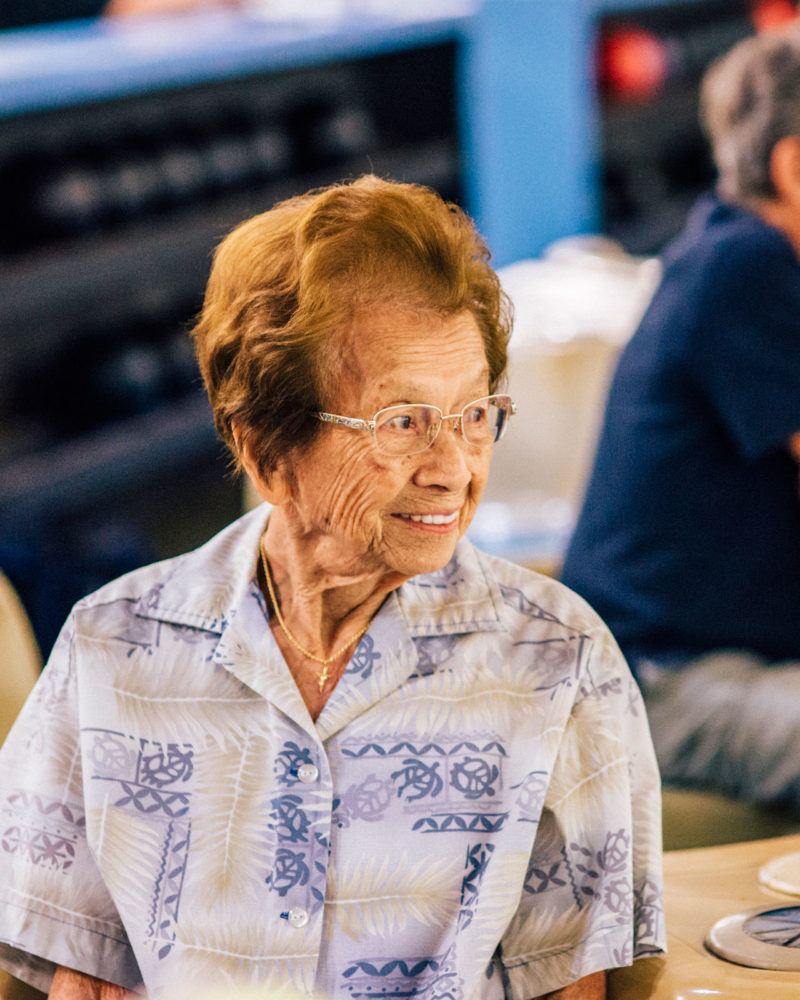Images by IJFke Ridgley
It was never just about saving a bowling alley.
On a recent Monday night, Arthur Machado, Jr. stood in front of the Koolau Seniors bowling league before their weekly match at Pali Lanes. He spoke passionately about saving the Kailua bowling alley he owned. He vaguely mentioned lawsuits, he talked about fighting Alexander and Baldwin. More than 5,000 people had signed the Save Pali Lanes online petition. In late 2017, Alexander and Baldwin, which owns the land under the bowling alley (as well as 38 acres in downtown Kailua, which it had purchased from Kaneohe Ranch and the Harold K.L. Castle Foundation in 2013) had announced that when the lease for the bowling alley expired in January 2019, it would raze the building to create a new community space, possibly an open area where farmers markets or food trucks could gather.
But Machado said it already was a gathering place, one for seniors on the Windward side of O‘ahu. It was an easy cause to get behind, and the Kailua community was inspired by the example set by the petition to save the monkeypod trees in Mānoa Marketplace, another property owned by Alexander and Baldwin. The developer had planned on removing the trees, but when it was presented with 20,000 signatures and a proposal for how to manage the trees’ roots, which were cracking the pavement, it decided against cutting them down.

By the time Machado spoke to the seniors that night, Alexander and Baldwin had already announced that it was putting its plans for Pali Lanes on hold. But people are still fired up. The bowling alley has come to represent something more than 24 lanes and a bunch of pins. It is a symbol of old Kailua, and it is something very tangible for the older residents of the community.
The senior bowlers who frequent Pali Lanes include Mary Sabate, who is 97 years old and still bowling with a 10-pound ball. When people tell her, “You too old for that,” she retorts, “What are you guys doing? Getting fat.”
Says Sabate, “My doctor says don’t walk the sidewalks, because they’re all uneven, you’ll break your neck or fracture your knee. Just keep rolling that ball. When the ladies want to quit, I say, no it’s your physical therapy, you need the exercise.” She had just returned from Reno, Nevada, where she competed in a women’s national bowling championship. It’s her 37th year participating in it. Asked how her team did, she says, “Well, you don’t expect the oldies to win [against] the younger ones.”
Sabate has lived in Kailua for 62 years, and started bowling before Pali Lanes was even built in 1961. Where there are now condominiums, she remembers a dairy farm and Kailua’s first bowling alley, which opened in 1947, around the same time as a telephone company branch office and Hawaiʻi’s very first supermarket.
If Pali Lanes closes, Sabate thinks she will retire from bowling. At a recent Kailua neighborhood board meeting, she said, “My biggest question for the people who want to tear it down: Do you folks have a plan for the seniors?”
But the solutions for the seniors are not as straightforward as managing the roots of the Mānoa Marketplace trees. “Bowling is a dying sport,” says Ruth Chatterton, secretary for the Koolau Seniors. At the Monday night bowl, the league, in which members compete against each other in teams of three, is two members short. One person had to drop out for medical reasons, another had passed away. She remembers when there were 36 bowling alleys on Oʻahu, including one that was literally underground, below Fort Street Mall in downtown Honolulu. Now there are only four: Aiea Bowl, Leeward Bowl, Barbers Point Bowling, and Pali Lanes. “The waitlist used to be so long for lanes, now I’m begging [people to join],” she says.

After Machado’s speech, he returns to his office, tucked in the back corner of the alley, past the concession stand. Here, Machado is quieter, more contemplative. There’s no mention of taking anyone to court, just a float for the Kailua 4th of July parade. He tenderly recounts his relationship with the sport. “Bowling has always been my love,” he says. Machado has been bowling for 54 years. He ran K-Bay Lanes on the Marine Corps Base Hawaii in Kāne‘ohe for a quarter of a century, from the day it opened in 1976. In 2010, he and two partners reopened Pali Lanes, which had closed at the end of 2009. But it has never made much money. Machado says it costs him $18,000 a month to run Pali Lanes, and he has been lucky if he gets one or two bowling party reservations a month. So when Alexander and Baldwin announced they would end his lease, Machado considered letting the bowling alley go. But then a group of 20-somethings who grew up in Kailua told him to fight for it, and they created the Save Pali Lanes petition. Reservations for the bowling alley flooded in, and it was booked every weekend from 10 a.m. to 9 p.m. for the summer. The public outcry over the demise of Pali Lanes has been enough for Alexander and Baldwin to pause its plans and reconsider.
The reaction might have surprised the developer, which probably saw an aging bowling alley frequented by a dwindling number of seniors, a few bowling leagues, and the occasional bored teen on a weekend night. But one’s crumbling eyesore is another’s symbol of nostalgia. Pali Lanes is one of the last vestiges of a Kailua that generations frequented and loved, before the tourists came in such droves that there are now laws to reign in commercial beach activity and street parking, before the low-slung, post-war era buildings that once characterized Kailua were demolished for commercial centers anchored by Target and Whole Foods. Nevermind that many of us didn’t go bowl, that many of us just saw Pali Lanes on our way to Target. Nevermind that we had forgotten about Pali Lanes until we heard it was closing.

Right now, Alexander and Baldwin isn’t making any promises about the fate of the bowling alley. It is conducting a round of surveys to “understand what the community’s interest and concerns are,” says its spokesman Darren Pai. “We don’t want to draw any conclusions at this point. We’ve really heard a whole range of opinions. Not just about this particular situation, but about Kailua.”
This is what the Save Pali Lanes petition was truly about all along. Evan Weber, who is from Kailua and created the petition, says, “Over the past couple of decades, there’s been a steady change in our town, loss of businesses for more places that serve the interests of developers by catering primarily to tourists and people who have not lived in Kailua their entire lives.” For the youth, who have a future longer than the past, there is more at stake. “Pali Lanes is a special place for families and community,” the 26-year-old adds, “and to me, this is the last straw over what’s been happening here.”

In contrast, Chatterton is resigned. “Guess we gotta go with progress,” she says. The Kailua she lived in when she was young is already long gone. She left Kapahulu for Kailua, left the city for the country, and stayed long enough for the city to catch up with her, to see the horse racetrack give way to Aikahi Shopping Center. She prefers the old Kailua, but admits to liking Target. And she knows interest in bowling is already waning. There’s talk of relocating the leagues to K-Bay Lanes if Kailua loses Pali Lanes. But even if that happens, Chatterton might retire anyway.



